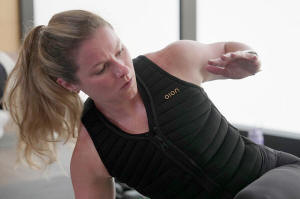Do weighted vests really help you get in shape faster?
[September 04, 2025]
By KENYA HUNTER
In the fitness class Jessie Syfko created for a nationwide gym chain,
exercisers wear weighted vests that add a challenge to their workouts.
“People start to realize how good it feels to work just a little bit
harder and a little bit smarter” without actually changing what they’re
doing, said Syfko, senior vice president for Life Time gyms.
Weighted vests are increasingly showing up in fitness classes and on
jogging tracks, touted by social media influencers as a way to keep
bones healthy, improve performance and even accelerate weight loss. They
are exactly what they sound like – vests that add resistance to the
torso through pockets with removable weights.
But there's a lack of robust research on their benefits, experts say, so
it's unclear how much of the hype is justified. And some people, such as
seniors or those who are pregnant, should be cautious about using them.
Here are the potential benefits of weighted vests
When you think about how exercise works, the idea that a weighted vest
will help you meet fitness goals like weight loss, muscle growth or
preventing bone loss might make sense on the surface. Adding weight to
the vest adds resistance to your everyday activities without changing up
your patterns.
The vests may, in fact, offer benefits for healthy adults, experts say –
although no one should expect transformative or instant results. Jeff
Monaco, a certified strength coach who teaches medical fitness at the
University of Texas at Austin, said while you may not lose a lot more
calories during a weighted vest exercise, resistance from the vest may
result in better sports performance over time.

“There are a lot of studies looking at (the weighted vest) from a speed
perspective in different athletics, like soccer, with changing
direction, agility and speed and so forth,” he said.
You’ll start to see those benefits by adding about 10% of your body
weight to the vest, he said. If you weigh 150 pounds, for example, that
would mean adding a total of 15 pounds to the vest.
But the research outside of sports isn’t as clear.
[to top of second column]
|

Nora Capocci wears a weighted vest during an MB360 workout class at
the Life Time health club in New York on Wednesday, Aug. 13, 2025.
(AP Photo/Shelby Lum)
 One 2020 study from Wake Forest
University School of Medicine in North Carolina found that adults
between 60 and 85 years old who wore weighted vests at times during
the day when they were most active lost about the same amount of
weight as those who didn’t wear them. They also lost the same amount
of bone density, which happens as we age but can be slowed by
building muscle.
Here's how to use weighted vests safely
Experts urge people to use weighted vests safely.
It’s best to start out by adding between five to 10 percent of your
body weight. Wearing a vest that’s too heavy can put unnecessary
strain on your joints, back and hips. That extra load can throw off
your posture, lead to poor form or even result in stress fractures
over time.
Some people should consult with a doctor before they throw on a
vest, said Dr. Elizabeth Gardner, a team physician for athletes at
Yale University. They include people who are pregnant, suffer from
heart and breathing conditions or have back or neck injuries.
You'll have to use the muscles in your abdomen to use a weighted
vest effectively, Gardner said, and this can be tougher for those
already managing back pain.
Before starting to use a vest, Monaco said it's always helpful to
get guidance from someone who has experience with them, “just to
make sure that your movements are good, your form is good, that you
have enough muscular upper body, muscular strength and endurance to
support that during your movements.”
But as long as you use it correctly, he said, a weighted vest can be
“a good tool to have in your toolbox.”
All contents © copyright 2025 Associated Press. All rights reserved |